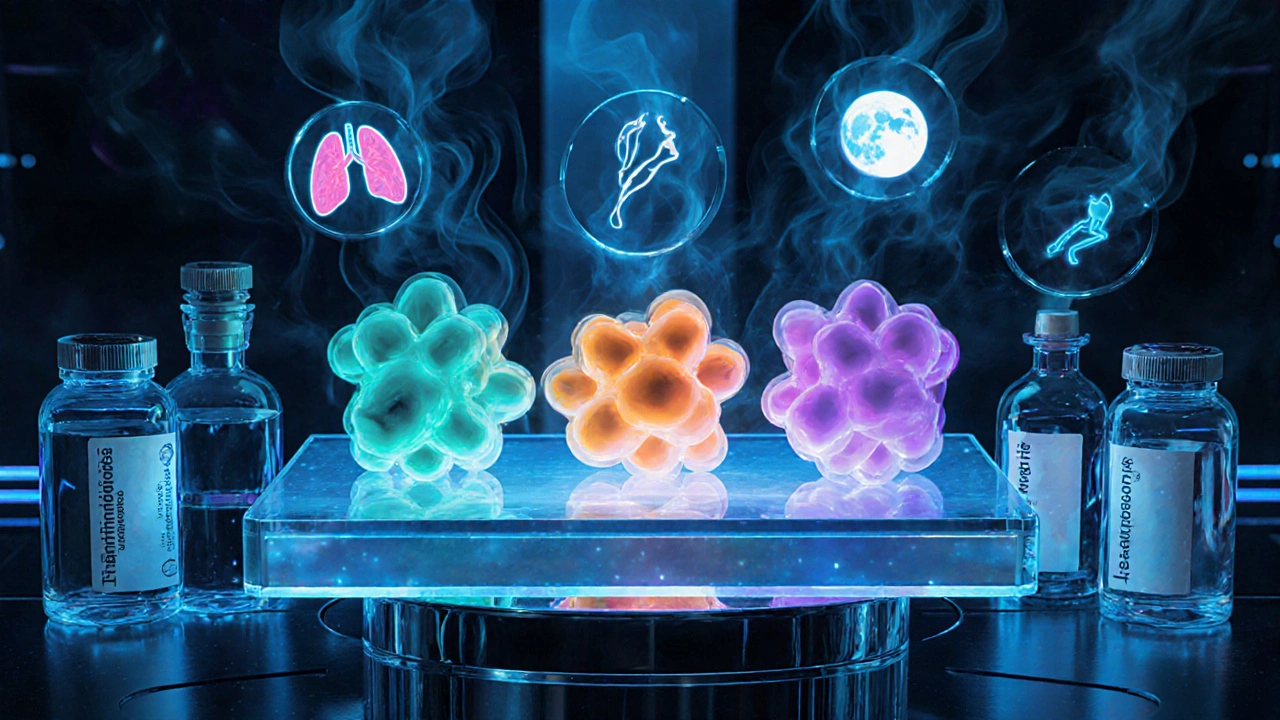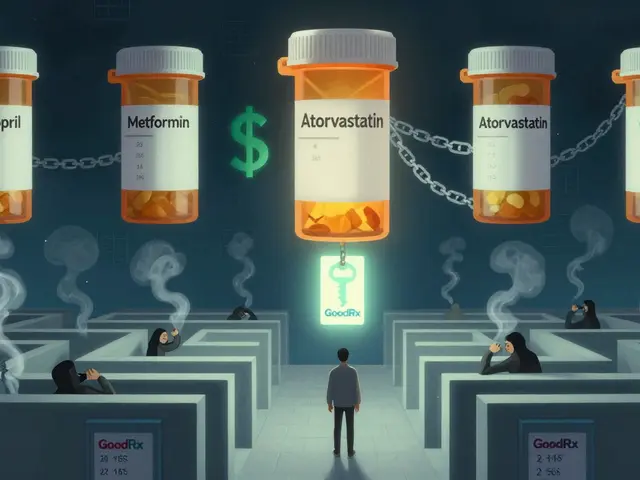
Corticosteroid Comparison Tool
Select a corticosteroid to compare its characteristics with Aristocort (Triamcinolone).
Comparison Table
| Drug | Formulation(s) | Relative Potency* | Typical Indications | Systemic Half-Life (hrs) |
|---|---|---|---|---|
| Triamcinolone (Aristocort) | Inhaler, IM injection, topical cream | 5 × hydrocortisone | Asthma, allergic rhinitis, skin inflammation, joint injections | 3-5 |
| Betamethasone | Topical cream, ophthalmic, injectable | ≈ 25 × hydrocortisone | Severe dermatitis, psoriasis, ocular inflammation | ~ 7 |
| Prednisone | Oral tablet | ≈ 4 × hydrocortisone | Autoimmune diseases, COPD exacerbations | 3-4 |
| Mometasone | Inhaler, nasal spray, topical | ≈ 5 × hydrocortisone | Asthma, allergic rhinitis, eczema | 5-6 |
| Budesonide | Inhaler, nasal spray, oral suspension | ≈ 3 × hydrocortisone | Asthma, chronic rhinosinusitis, Crohn’s disease | 2-3 |
| Fluticasone | Inhaler, nasal spray | ≈ 5-6 × hydrocortisone | Asthma, COPD, allergic rhinitis | ~ 8 |
| Dexamethasone | Oral, IV, IM, ophthalmic | ≈ 25 × hydrocortisone | Brain edema, COVID-19, chemotherapy prophylaxis | 36-54 |
| Hydrocortisone | Topical cream, oral, injectable | 1 × hydrocortisone (baseline) | Mild dermatitis, adrenal insufficiency | 1-2 |
*Potency expressed relative to hydrocortisone, the reference standard.
Aristocort is a brand name for triamcinolone acetonide, a synthetic glucocorticoid used in inhaled, injectable and topical forms to reduce inflammation. It works by binding to intracellular glucocorticoid receptors, altering gene transcription and dampening the immune response.
Why Compare Aristocort with Other Steroids?
Patients and clinicians often face a maze of steroid options. Choosing the right one hinges on potency, delivery method, half‑life, and side‑effect profile. By laying the features side‑by‑side, you can match a drug to a condition-whether it’s asthma, eczema, or joint pain-without guessing.
Key Players in the Corticosteroid Landscape
Beyond Aristocort, the market offers several closely related agents:
- Betamethasone is a high‑potency topical steroid frequently prescribed for severe dermatologic inflammation.
- Prednisone is an oral systemic corticosteroid used for a wide range of autoimmune and inflammatory disorders.
- Mometasone is a medium‑potency inhaled steroid marketed for asthma and allergic rhinitis.
- Budesonide is an inhaled corticosteroid with a favorable safety profile for chronic respiratory disease.
- Fluticasone is a potent inhaled steroid often combined with long‑acting bronchodilators for COPD management.
- Dexamethasone is a long‑acting synthetic steroid used in chemotherapy‑induced nausea, COVID‑19 protocols, and intra‑articular injections.
- Hydrocortisone is a low‑potency steroid that mimics natural cortisol, commonly used for mild skin irritation.
How Aristocort Stacks Up - Core Attributes
Understanding the pharmacokinetics helps predict outcomes:
- Potency: Triamcinolone is roughly 5‑times more potent than hydrocortisone and comparable to betamethasone in topical form.
- Onset of Action: Inhaled triamcinolone reaches peak bronchodilation within 1‑2hours, faster than prednisone’s systemic effects.
- Half‑Life: The systemic half‑life of triamcinolone acetonide is about 3‑5hours, shorter than dexamethasone’s 36‑hour duration.
- Formulations: Available as inhaler, intramuscular injection, and cream. This flexibility makes it a bridge between local and systemic therapy.
Quick Reference Comparison Table
| Drug | Formulation(s) | Relative Potency* | Typical Indications | Systemic Half‑Life (hrs) |
|---|---|---|---|---|
| Triamcinolone (Aristocort) | Inhaler, IM injection, topical cream | 5×hydrocortisone | Asthma, allergic rhinitis, skin inflammation, joint injections | 3‑5 |
| Betamethasone | Topical cream, ophthalmic, injectable | ≈25×hydrocortisone | Severe dermatitis, psoriasis, ocular inflammation | ~7 |
| Prednisone | Oral tablet | ≈4×hydrocortisone | Autoimmune diseases, COPD exacerbations | 3‑4 |
| Mometasone | Inhaler, nasal spray, topical | ≈5×hydrocortisone | Asthma, allergic rhinitis, eczema | 5‑6 |
| Budesonide | Inhaler, nasal spray, oral suspension | ≈3×hydrocortisone | Asthma, chronic rhinosinusitis, Crohn’s disease | 2‑3 |
| Fluticasone | Inhaler, nasal spray | ≈5‑6×hydrocortisone | Asthma, COPD, allergic rhinitis | ~8 |
| Dexamethasone | Oral, IV, IM, ophthalmic | ≈25×hydrocortisone | Brain edema, COVID‑19, chemotherapy prophylaxis | 36‑54 |
| Hydrocortisone | Topical cream, oral, injectable | 1×hydrocortisone (baseline) | Mild dermatitis, adrenal insufficiency | 1‑2 |
*Potency expressed relative to hydrocortisone, the reference standard.

Choosing the Right Steroid for Your Situation
Here’s a quick decision‑tree you can sketch on a napkin:
- If you need rapid, local airway relief and prefer an inhaler, look at Triamcinolone, Mometasone or Budesonide. Budesonide offers the shortest half‑life, which can be a safety edge for children.
- For severe skin disease demanding high potency, switch to Betamethasone or Dexamethasone (topical forms).
- When systemic suppression is required-think lupus or severe asthma exacerbation-Prednisone is the go‑to oral option. Pair it with a short‑acting inhaled steroid to taper down.
- If you’re concerned about bone loss or hyperglycemia, choose a steroid with a shorter systemic half‑life like Triamcinolone or Budesonide and keep the dosage minimal.
Always discuss with a healthcare professional, as individual metabolism (CYP3A4 activity) can shift these general rules.
Side‑Effect Profile - What to Watch For
While all glucocorticoids share a core risk set, the magnitude varies:
- Oral/systemic steroids (Prednisone, Dexamethasone) carry the highest risk of HPA‑axis suppression, weight gain, and mood swings.
- Inhaled steroids (Triamcinolone, Budesonide, Fluticasone) can cause oral thrush, hoarse voice, and mild systemic absorption-especially at doses >800µg/day.
- Topical steroids (Betamethasone, Hydrocortisone) may thin skin, trigger telangiectasia, or cause perioral dermatitis if overused.
Mitigation tips:
- Rinse mouth after inhalation.
- Use the lowest effective dose for the shortest duration.
- Monitor blood glucose if you have diabetes.
- Schedule a bone‑density scan for long‑term users.
Related Concepts - Connecting the Dots
Understanding steroids often leads to adjacent topics:
- HPA Axis - the hormonal feedback loop that steroids suppress.
- Peak Flow Monitoring - a practical tool to gauge inhaled steroid efficacy.
- Step‑wise Asthma Management - where inhaled glucocorticoids sit alongside bronchodilators.
- Topical Steroid Classification - low, medium, high potency categories that guide skin therapy.
- Drug‑Drug Interactions - especially CYP3A4 inducers/inhibitors affecting steroid metabolism.
Exploring these ideas will deepen your ability to personalize treatment and anticipate side‑effects.
Practical Tips for Patients and Prescribers
Whether you’re a pharmacist, a clinician, or a patient, these actions help keep therapy safe:
- Check device technique - improper inhaler use can halve the dose delivered.
- Review the steroid’s potency before switching brands; high‑potency swaps may need a taper.
- Document any prior steroid exposure to avoid inadvertent cumulative dosing.
- Ask about rescue medications-a short‑acting bronchodilator should accompany long‑term steroids for asthma.
- Schedule follow‑up labs if using systemic steroids for more than two weeks (glucose, electrolytes, CBC).
Bottom Line
Aristocort (triamcinolone) sits comfortably in the mid‑potency range, offering versatility across inhaled, injectable, and topical routes. It’s less potent than betamethasone or dexamethasone but more potent than hydrocortisone, making it a balanced choice for many inflammatory conditions. Matching the drug’s pharmacology to the disease severity, delivery preference, and patient risk factors is the key to optimal outcomes.

Frequently Asked Questions
How does triamcinolone differ from prednisone?
Triamcinolone is typically administered via inhaler, injection or cream and has a shorter systemic half‑life (3‑5hours) than prednisone’s 3‑4hours oral form. Prednisone provides broader systemic coverage, whereas triamcinolone offers more targeted anti‑inflammatory effects with lower systemic exposure when used as an inhaler.
Is Aristocort safe for children with asthma?
Yes, when dosed appropriately (usually ≤200µg twice daily) and combined with proper inhaler technique, Aristocort is considered safe for pediatric asthma. Monitoring for growth suppression is advised for long‑term use.
Can I switch from Budesonide to Triamcinolone without a taper?
Because both are inhaled steroids with comparable potency, a direct switch is generally acceptable if the total daily dose remains equivalent. However, confirming dose equivalence with a clinician prevents inadvertent over‑ or under‑treatment.
What are the most common side effects of topical triamcinolone?
Skin irritation, burning, and rare skin atrophy when used over large areas or for extended periods. Using the lowest effective concentration and limiting application time reduces these risks.
How does fluticasone compare in potency to triamcinolone?
Fluticasone is slightly more potent, roughly 5‑6times the strength of hydrocortisone, versus triamcinolone’s 5‑times. Clinically, the difference is modest, but fluticasone’s longer half‑life (≈8hours) can provide smoother control for nocturnal asthma.






10 Comments
Love the breakdown! 😊
/p>Yo, if you’re rockin’ an inhaler, make sure you shake it good before each puff – trust me, a sloppy shake can waste half the dose. Gotta prime it right, click the mouthpiece, and breathe in slow‑and‑steady, not a crazy gasp. Also, rinse your mouth after each use, otherwise you’ll end up with that nasty thrush. Stay on top of the technique and you’ll feel the relief faster than you think.
/p>Listen up, compatriots! The steroid arena is a battlefield of potency, and triamcinolone stands tall as the seasoned warrior bridging the gap between the meek hydrocortisone and the titan dexamethasone. Its pharmacokinetic profile, with a half‑life of 3‑5 hours, offers a tactical advantage for acute flares without the long‑term systemic siege associated with heavyweight agents. When you stack it against betamethasone, you’re looking at a similar potency but a more versatile delivery arsenal – inhaler, IM, and cream. Remember, misusing high‑potency steroids can trigger a cascade of iatrogenic complications that no one wants in their medical dossier.
/p>While your enthusiasm for triamcinolone’s versatility is noted, the claim that it "bridges the gap" between hydrocortisone and dexamethasone oversimplifies the pharmacodynamic nuances. Potency is not a linear scale; a five‑fold increase over hydrocortisone does not equate to the same clinical impact as a twenty‑five‑fold increase. Additionally, the statement about “avoiding long‑term systemic siege” neglects the cumulative effect of repeated inhaled doses, which can still suppress the HPA axis. A more precise comparison would reference specific receptor affinity values and systemic exposure metrics.
/p>Using steroids responsibly is a moral duty; over‑prescribing leads to avoidable harm. Keep doses low and monitor side‑effects.
/p>Great job laying out the table! If you’re undecided, try the interactive tool to see real‑time potency differences. It’s a solid way to match the right steroid to your specific condition.
/p>Appreciate the thorough breakdown, especially the side‑effect section. I’ve found that pairing a short‑acting inhaler with a low‑dose oral steroid can smooth out flare‑ups without piling on risk. Keep sharing these clear guides!
/p>For newcomers, remember that cultural practices can influence how patients view inhaler use; some prefer traditional remedies before steroids. Encourage open dialogue and respect each individual’s comfort zone.
/p>Check half‑life; compare potency; adjust dose.
/p>Alright folks, let’s dive deep into why choosing the right corticosteroid feels like navigating a labyrinth with a flashlight that’s constantly flickering. First off, understand that potency isn’t just a number on a chart – it translates to how aggressively the drug will shut down inflammation, and that can be a double‑edged sword. If you’re dealing with mild eczema, throwing a high‑potency steroid like betamethasone at it is like using a sledgehammer to crack a walnut; you risk skin thinning, telangiectasia, and a whole host of unnecessary side‑effects. On the other hand, for severe asthma exacerbations, you need something that hits fast and stays effective long enough to give your airways a breather, which is where triamcinolone’s 3‑5 hour half‑life shines – it’s quick enough to avoid buildup yet potent enough to quell the fire.
/p>Now, think about delivery routes: inhalers deliver drug directly to the lungs, minimizing systemic absorption, while oral steroids like prednisone flood the whole body, increasing the odds of HPA‑axis suppression, weight gain, and mood swings.
One trick I’ve learned over the years is to pair a low‑dose inhaled steroid with a short burst of oral prednisone during flare‑ups; this hybrid approach gives you the best of both worlds – targeted relief plus systemic coverage when needed.
Don’t forget about patient adherence – a complicated regimen with multiple devices can lead to missed doses, so simplify wherever possible.
Also, monitor labs regularly if you’re on systemic steroids for more than two weeks; fasting glucose, CBC, and bone density scans become your friends.
Remember to educate patients about rinsing their mouth after inhaler use to prevent thrush – a simple habit that saves a lot of discomfort.
For those concerned about long‑term bone health, consider adding calcium and vitamin D supplements, and discuss bisphosphonate therapy if risk factors stack up.
Finally, always individualize therapy – age, comorbidities, CYP3A4 interactions, and even genetic polymorphisms can shift how a patient metabolizes these drugs.
Bottom line: match potency, half‑life, and delivery method to the disease severity and patient lifestyle, and you’ll hit the sweet spot where inflammation is controlled without unwanted fallout. 🌟